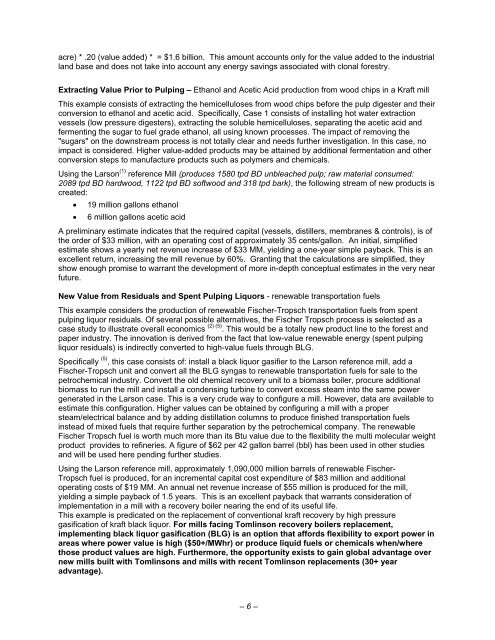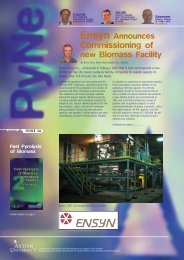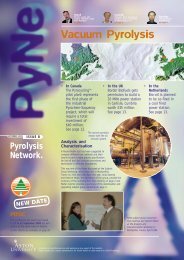The integrated forest products biorefinery by Gerrard Closset ... - Pyne
The integrated forest products biorefinery by Gerrard Closset ... - Pyne
The integrated forest products biorefinery by Gerrard Closset ... - Pyne
Create successful ePaper yourself
Turn your PDF publications into a flip-book with our unique Google optimized e-Paper software.
acre) * .20 (value added) * = $1.6 billion. This amount accounts only for the value added to the industrialland base and does not take into account any energy savings associated with clonal <strong>forest</strong>ry.Extracting Value Prior to Pulping – Ethanol and Acetic Acid production from wood chips in a Kraft millThis example consists of extracting the hemicelluloses from wood chips before the pulp digester and theirconversion to ethanol and acetic acid. Specifically, Case 1 consists of installing hot water extractionvessels (low pressure digesters), extracting the soluble hemicelluloses, separating the acetic acid andfermenting the sugar to fuel grade ethanol, all using known processes. <strong>The</strong> impact of removing the"sugars" on the downstream process is not totally clear and needs further investigation. In this case, noimpact is considered. Higher value-added <strong>products</strong> may be attained <strong>by</strong> additional fermentation and otherconversion steps to manufacture <strong>products</strong> such as polymers and chemicals.Using the Larson (1) reference Mill (produces 1580 tpd BD unbleached pulp; raw material consumed:2089 tpd BD hardwood, 1122 tpd BD softwood and 318 tpd bark), the following stream of new <strong>products</strong> iscreated:• 19 million gallons ethanol• 6 million gallons acetic acidA preliminary estimate indicates that the required capital (vessels, distillers, membranes & controls), is ofthe order of $33 million, with an operating cost of approximately 35 cents/gallon. An initial, simplifiedestimate shows a yearly net revenue increase of $33 MM, yielding a one-year simple payback. This is anexcellent return, increasing the mill revenue <strong>by</strong> 60%. Granting that the calculations are simplified, theyshow enough promise to warrant the development of more in-depth conceptual estimates in the very nearfuture.New Value from Residuals and Spent Pulping Liquors - renewable transportation fuelsThis example considers the production of renewable Fischer-Tropsch transportation fuels from spentpulping liquor residuals. Of several possible alternatives, the Fischer Tropsch process is selected as acase study to illustrate overall economics (2) (5) . This would be a totally new product line to the <strong>forest</strong> andpaper industry. <strong>The</strong> innovation is derived from the fact that low-value renewable energy (spent pulpingliquor residuals) is indirectly converted to high-value fuels through BLG.Specifically (5) , this case consists of: install a black liquor gasifier to the Larson reference mill, add aFischer-Tropsch unit and convert all the BLG syngas to renewable transportation fuels for sale to thepetrochemical industry. Convert the old chemical recovery unit to a biomass boiler, procure additionalbiomass to run the mill and install a condensing turbine to convert excess steam into the same powergenerated in the Larson case. This is a very crude way to configure a mill. However, data are available toestimate this configuration. Higher values can be obtained <strong>by</strong> configuring a mill with a propersteam/electrical balance and <strong>by</strong> adding distillation columns to produce finished transportation fuelsinstead of mixed fuels that require further separation <strong>by</strong> the petrochemical company. <strong>The</strong> renewableFischer Tropsch fuel is worth much more than its Btu value due to the flexibility the multi molecular weightproduct provides to refineries. A figure of $62 per 42 gallon barrel (bbl) has been used in other studiesand will be used here pending further studies.Using the Larson reference mill, approximately 1,090,000 million barrels of renewable Fischer-Tropsch fuel is produced, for an incremental capital cost expenditure of $83 million and additionaloperating costs of $19 MM. An annual net revenue increase of $55 million is produced for the mill,yielding a simple payback of 1.5 years. This is an excellent payback that warrants consideration ofimplementation in a mill with a recovery boiler nearing the end of its useful life.This example is predicated on the replacement of conventional kraft recovery <strong>by</strong> high pressuregasification of kraft black liquor. For mills facing Tomlinson recovery boilers replacement,implementing black liquor gasification (BLG) is an option that affords flexibility to export power inareas where power value is high ($50+/MWhr) or produce liquid fuels or chemicals when/wherethose product values are high. Furthermore, the opportunity exists to gain global advantage overnew mills built with Tomlinsons and mills with recent Tomlinson replacements (30+ yearadvantage).– 6 –






